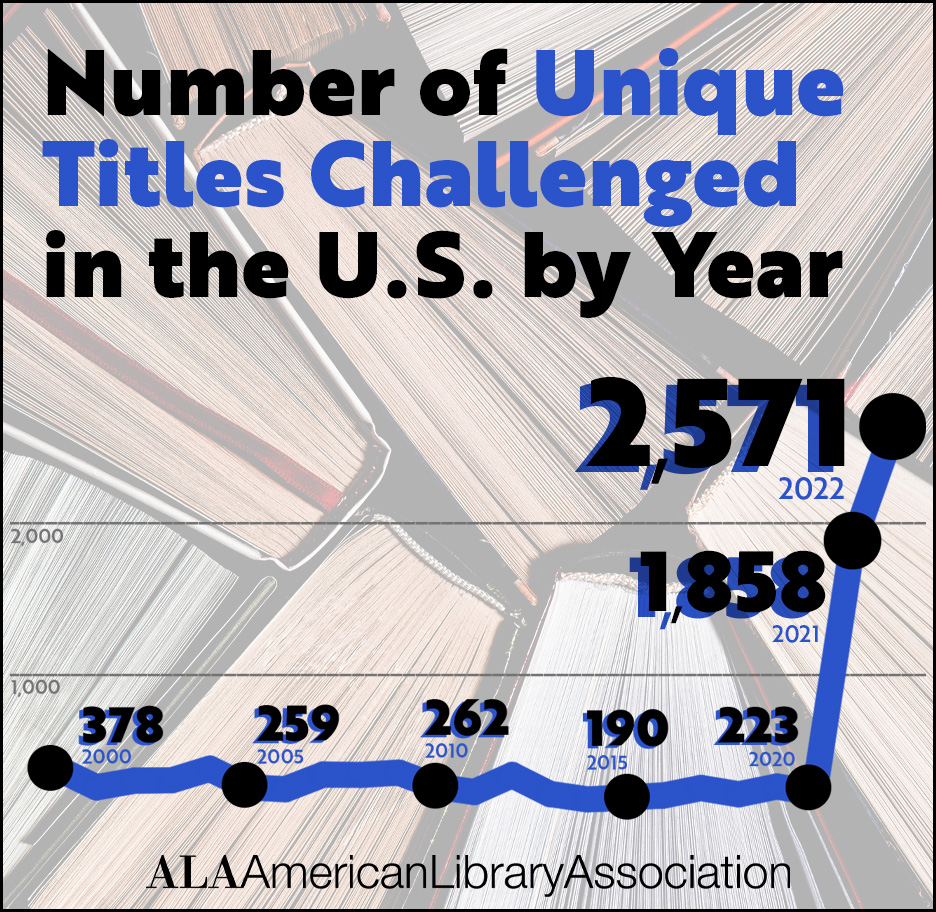Here is Charlie on the landing of our stairway. He likes to sit here so that he can keep track of everyone who goes up and down.
Trump shills should be forced to defend Trump
Back in 2015 Jake Tapper moderated a Republican primary debate in which nearly every question was framed in terms of something "Donald Trump recently said..." And this was back when Trump wasn't even leading in the polls and certainly wasn't a former president.
Today there's way more justification for doing this, but instead it's disappeared as an art form. Why? Trump recently implied, for example, that Gen. Mark Milley should be executed for treason. I'd like to know what Ron DeSantis thinks of this! If I cared what Vivek Ramaswamy thought about anything I'd be curious to know his reaction too.
But nobody asked this at Wednesday's debate. Why not?
Sexually explicit YA books lead to . . . less teen sex?
The Washington Post tells us today about Jennifer Petersen, a Virginia mother who's a serial book challenger. She has so far challenged 73 books in the Spotsylvania school district, all for sexual content. The Post confirmed that this had nothing to do with race or sexual orientation: Petersen objects to any book containing graphic descriptions of sex.
Why? A couple of years ago she attended a school board meeting where parents denounced a couple of books for their sexual content:
Petersen, too, was alarmed. If children under 18 read about sex, she worries, they will be more likely to engage in unsafe sex or fall victim to sexual predators.
Hmmm. YA literature has generally gotten more graphic over the past couple of decades. Here's the result:
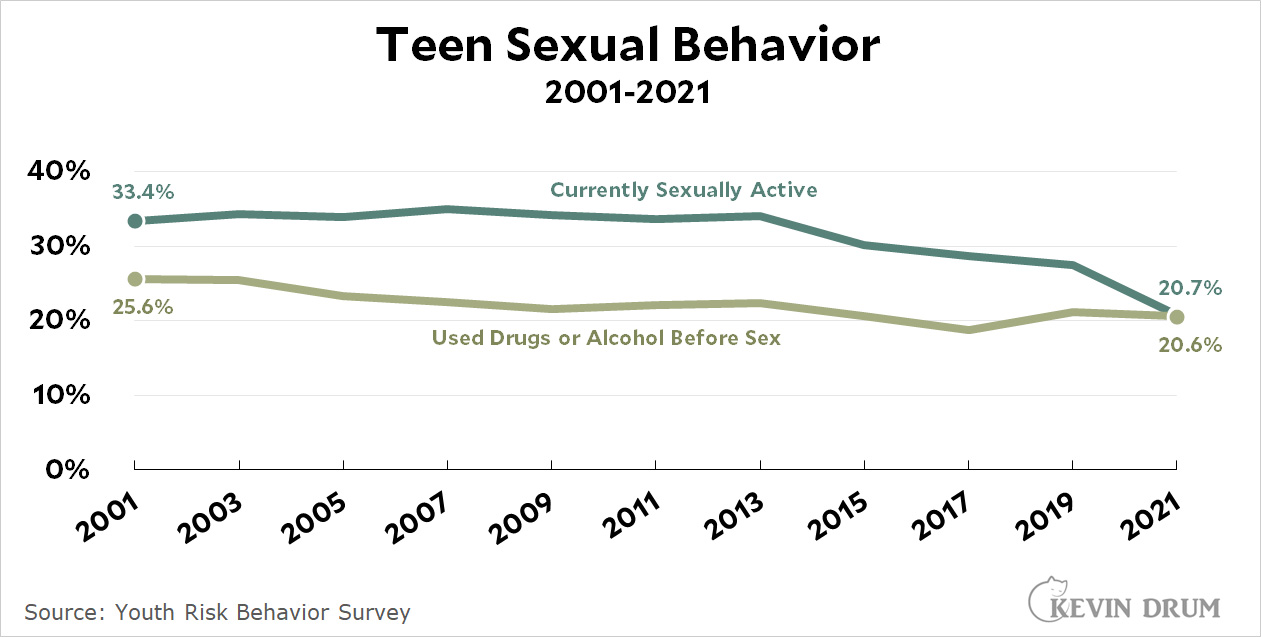 To the extent we can measure it, both teen sex and risky teen sex have gone down. There's no telling what's caused this, but if sexually explicit books are producing more teen sex of any kind, it sure doesn't show up in the numbers.
To the extent we can measure it, both teen sex and risky teen sex have gone down. There's no telling what's caused this, but if sexually explicit books are producing more teen sex of any kind, it sure doesn't show up in the numbers.
As it happens, I have my own pet theory about this. I've perused current YA books from time to time, and they are bleak as hell. If I were brought up on a diet of this stuff I'd probably swear off sex forever. Neither side in this debate realizes it, but I suspect the combination of graphic sex and disturbing stories has contributed to less sexual activity, not more.
I don't suppose very many people will buy this theory, but give it some thought! It might grow on you.
And just so you know, here's an estimate from the American Library Association of the spike in school book challenges over the past couple of years. Please don't blame me for the hideous shadowing on the numbers.
Consumer spending up slightly in August
If it's PCE inflation day, it must also be PCE spending day. So how much did consumers spend last month?
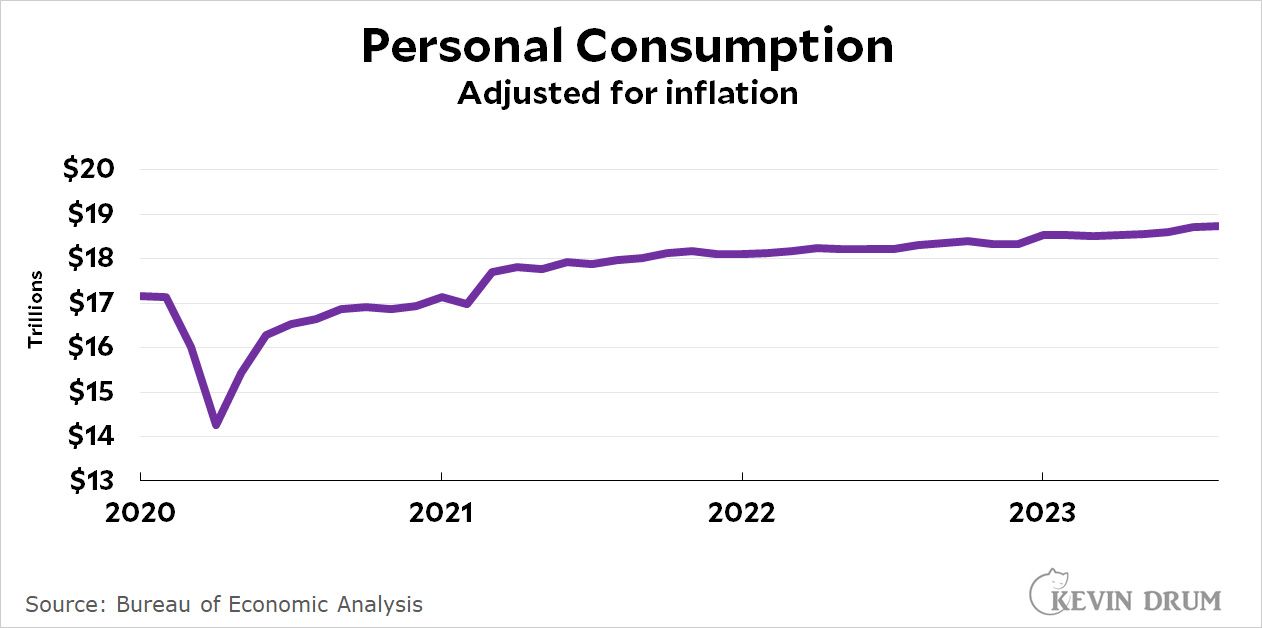 Spending was up 0.6% from the previous month on an annualized basis. It was up 2.3% from the previous year.
Spending was up 0.6% from the previous month on an annualized basis. It was up 2.3% from the previous year.
So spending continues to increase. Not by much, though.
Core PCE inflation dropped below 2% in August
We have some pretty good news on inflation today:
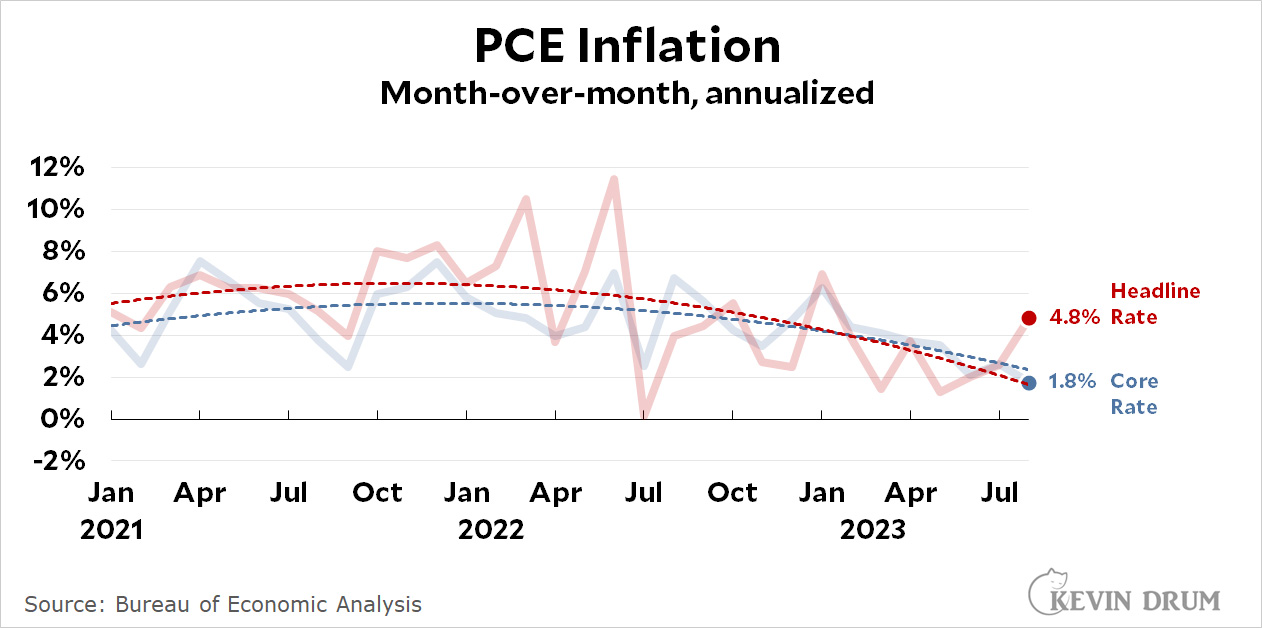 The headline rate of PCE inflation spiked up to 4.8%, which was fully expected due to rising gasoline prices, but the core rate dropped to 1.8%. The core rate is (say it with me) the Fed's preferred measure of inflation, and it's no longer "heading toward 2%." It's below 2%.
The headline rate of PCE inflation spiked up to 4.8%, which was fully expected due to rising gasoline prices, but the core rate dropped to 1.8%. The core rate is (say it with me) the Fed's preferred measure of inflation, and it's no longer "heading toward 2%." It's below 2%.
On a conventional year-over-year basis, headline inflation came in at 3.5% and core inflation was 3.9%.
Lead and crime in Washington DC
Yesterday I ran across an item about the high murder rate in Washington DC. I also happened to remember this, based on the research of Marc Edwards:
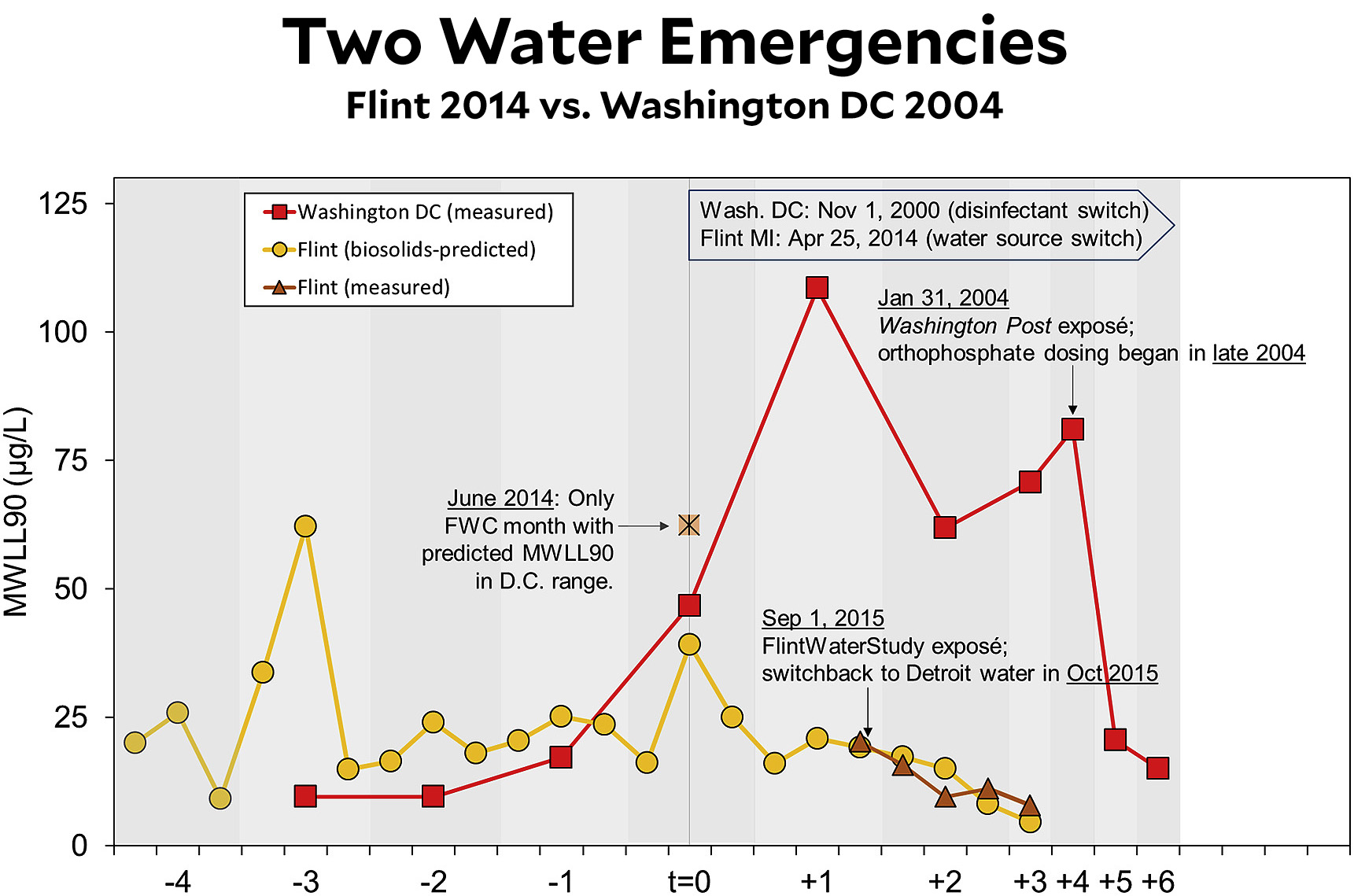 Beginning in the year 2000, Washington DC experienced an episode of lead contamination in its drinking water that wasn't discovered until 2004. For five years, DC's kids were drinking water with highly elevated levels of lead.
Beginning in the year 2000, Washington DC experienced an episode of lead contamination in its drinking water that wasn't discovered until 2004. For five years, DC's kids were drinking water with highly elevated levels of lead.
I adjusted the lead numbers so they'd nicely overlay the DC murder rate with a 20-year lag.¹ Here's what it looks like:
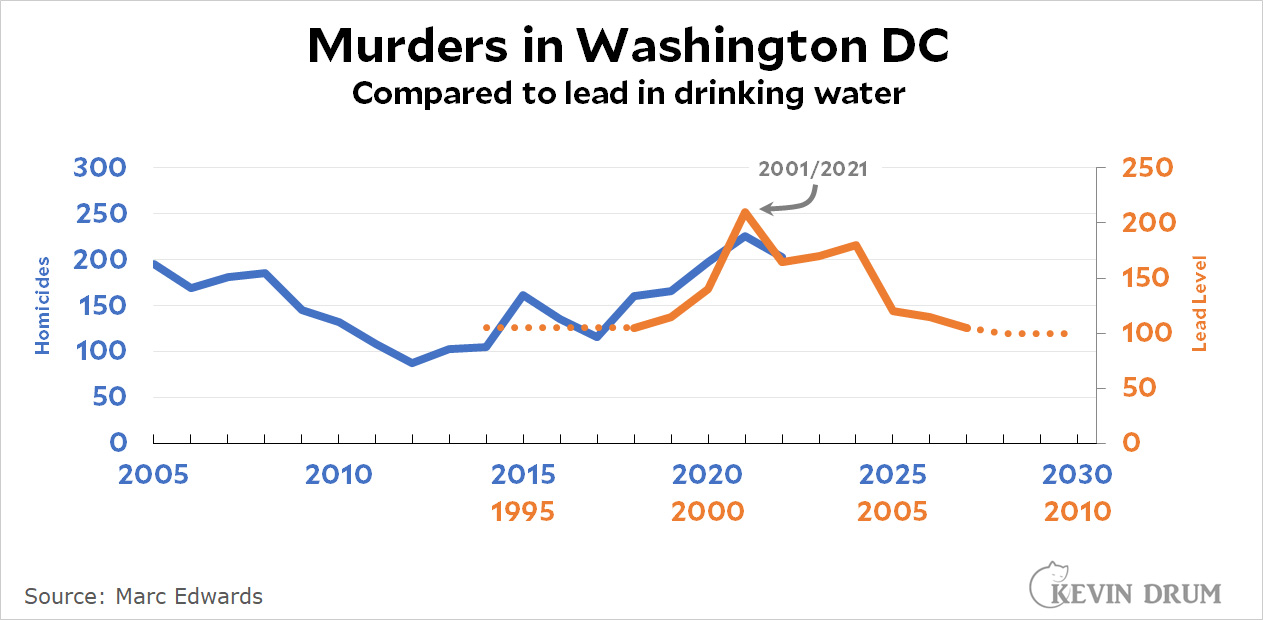 Crime has lots of causes—and correlations like this one are especially tricky in small regions over short periods of time—but it's interesting nonetheless, isn't it? It sure looks like the lead crisis of 2000-2004 produced a cohort of kids 20 years later who are more likely than usual to commit murders.
Crime has lots of causes—and correlations like this one are especially tricky in small regions over short periods of time—but it's interesting nonetheless, isn't it? It sure looks like the lead crisis of 2000-2004 produced a cohort of kids 20 years later who are more likely than usual to commit murders.
¹I shifted the lead levels up by 100 and squeezed them slightly. It's all kosher and produces a normal correlation equation. I did this solely to make everything visually clearer.
NOTE: I'd like to check lead levels vs. the violent crime rate, but (a) the FBI's violent crime figures only go through 2020 before becoming unreliable, and (b) NCVS doesn't track crime in individual states and cities. So the DC murder rate is the best I can do.
Rising mortality is mostly limited to white high school dropouts
This chart is making the rounds on Twitter:
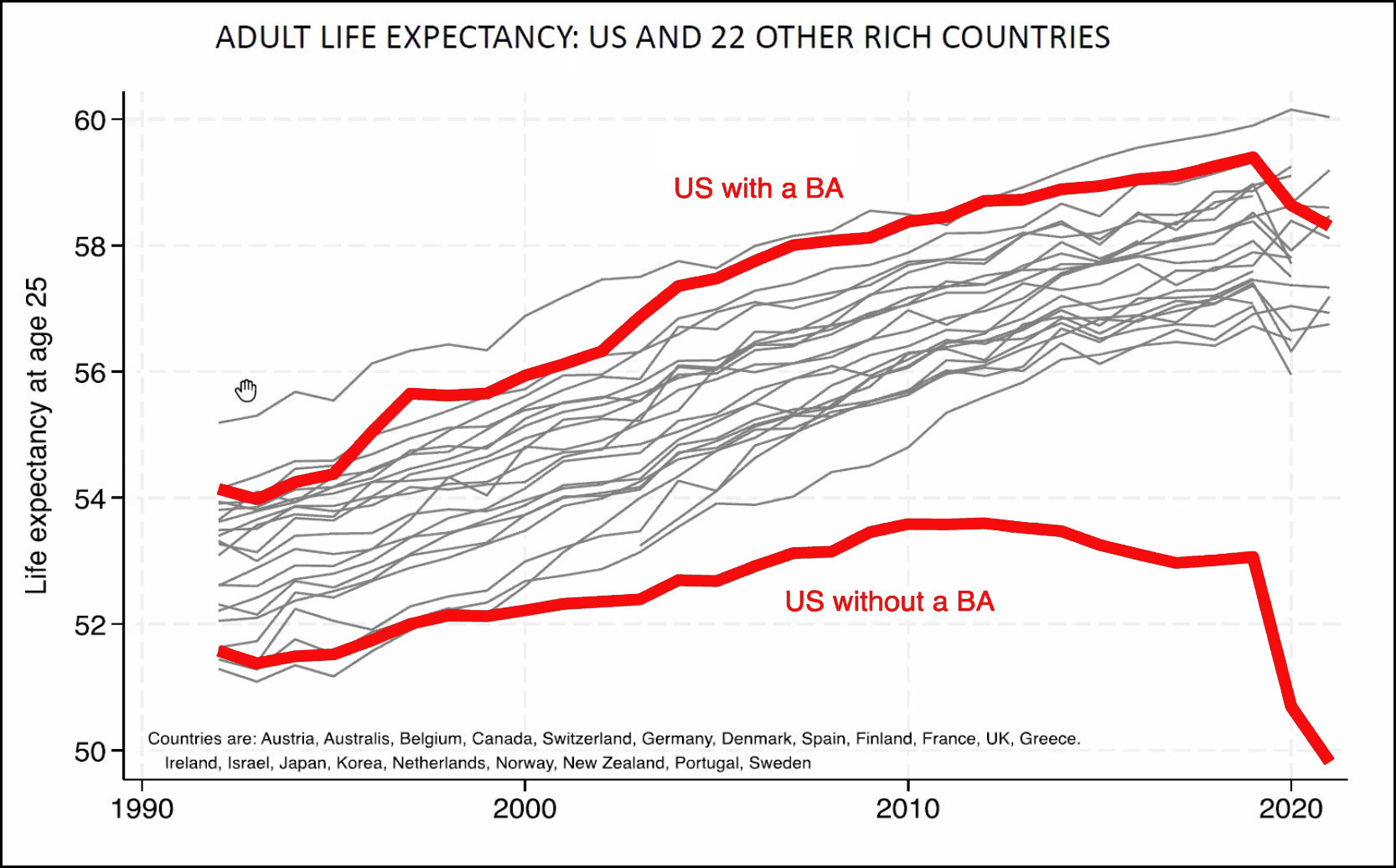 A paper from a few years ago breaks this down in more detail. After a big pile o' math, here's what it tells us:
A paper from a few years ago breaks this down in more detail. After a big pile o' math, here's what it tells us:
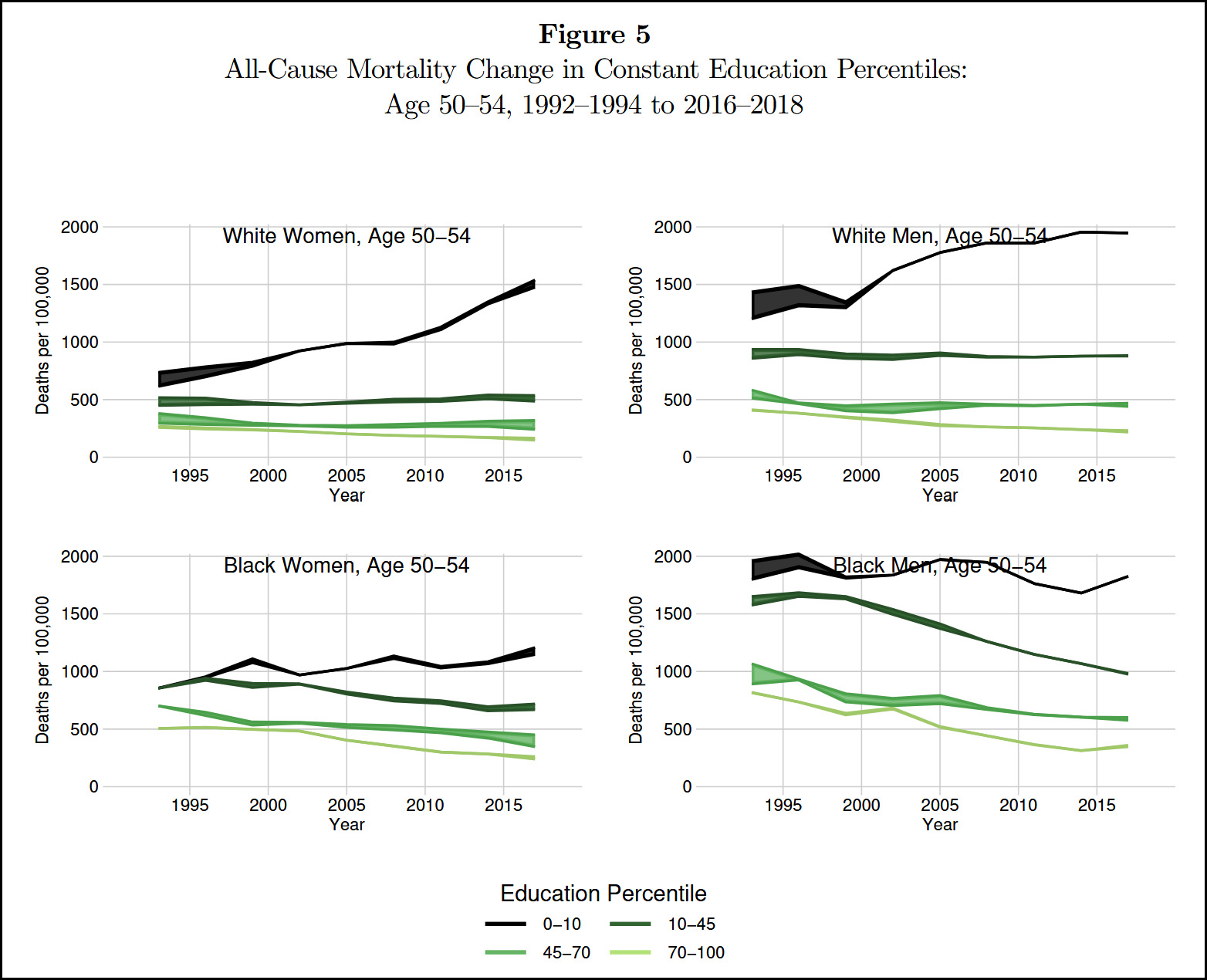 Note that the bottom figure is a chart of mortality, so higher is worse. And what it shows is that our middle-aged mortality problem isn't broadly about everyone without a BA. It's specifically about white high school dropouts (the bottom 10% of the education spectrum). The data only goes through 2018, but I imagine that if it included more recent years it would show that the big life expectancy decline due to COVID is also heavily centered on high school dropouts.
Note that the bottom figure is a chart of mortality, so higher is worse. And what it shows is that our middle-aged mortality problem isn't broadly about everyone without a BA. It's specifically about white high school dropouts (the bottom 10% of the education spectrum). The data only goes through 2018, but I imagine that if it included more recent years it would show that the big life expectancy decline due to COVID is also heavily centered on high school dropouts.
Why? One probable factor is 15 years of falling wages from an already paltry level:
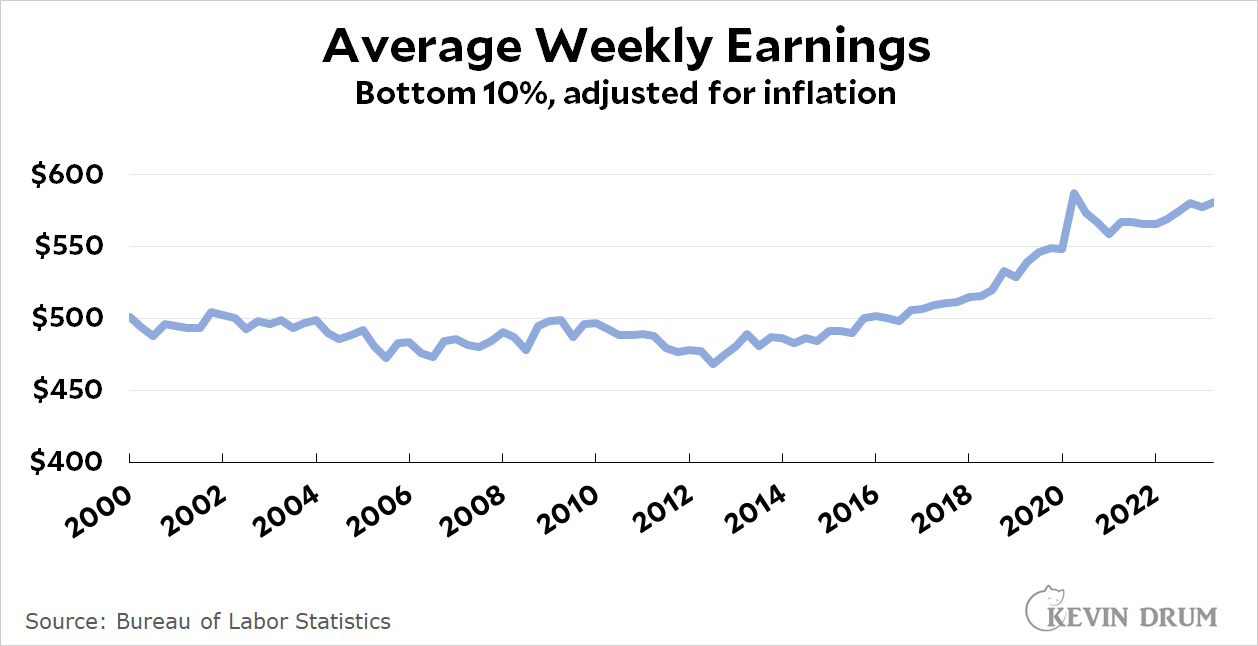 Average earnings of the poorest 10% were lower in 2015 than in 2000. It wasn't until 2016 that they started to increase. If the rising mortality rate among high school dropouts really is due to deaths of despair, it's hardly any wonder.
Average earnings of the poorest 10% were lower in 2015 than in 2000. It wasn't until 2016 that they started to increase. If the rising mortality rate among high school dropouts really is due to deaths of despair, it's hardly any wonder.
Appeals court tells Trump to buzz off
As predicted, an appellate judge has tossed out Donald Trump's lawsuit against the trial judge in his business fraud case:
The appeals court, in a terse two-page order Thursday, effectively turned aside for now a lawsuit Mr. Trump filed against the trial judge, Arthur F. Engoron. The lawsuit had sought to delay the trial, and ultimately throw out many of the accusations against the former president.
"Terse"! It's amazing the way things work when you can't forum shop for a Texas judge you appointed yourself.
Anyway, the trial judge has already pronounced Trump guilty, so all that's left is for him to decide on Trump's punishment. This might happen as soon as next week.
Trump, of course, will also appeal that, so tack on another year or so before everything becomes final. It's possible that by Election Day Trump will be a quarter of a billion dollars poorer; no longer in control of his company; banned from doing business in New York; and on his way to prison. It couldn't happen to a more deserving guy.
Lunchtime Photo
Rare earths aren’t rare
I suppose no one cares, but last night Doug Burgum said this:
China controls 85 percent of the Rare Earth minerals. They’re called Rare Earth, because they’re measured in parts per million.
Nah. They're measured in grams or kilograms, just like everything else. They're only called "rare" earths because they were rare 200 years ago when they were first discovered. China mined about 300,000 metric tons of the stuff last year, up from 100,000 metric tons a decade ago. A mine in California is already producing rare earths and a mine in Texas will open soon. Sweden, the original home of rare earths, recently announced it had discovered a deposit of more than a million metric tons.
The issue with rare earths is not that they're especially rare. The issue is that China has low wages and lax environmental laws, which allows them to produce and refine the stuff cheaply. Two-thirds of all rare earth deposits are outside China, which means the rest of the world can catch up whenever it wants to. It will just be more expensive than Chinese product, that's all.


